How to make a stool with your own hands?

Today, the comfort of life has become an important aspect for many. And this is not surprising, because it allows you to save time, devote more things to the main thing and just relax. Furniture is a necessary attribute that can significantly improve the comfort of people's lives. One of the important elements of any interior is a stool. This product today can be made from a fairly wide range of materials. Let's try to figure out how to make it at home with our own hands.
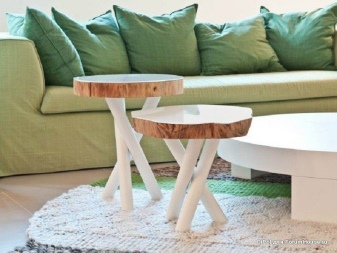

Tools and materials
It should be said that before you start considering the process of creating a simple stool yourself, you need to know that the most popular are log and bar stools... But these, if I may say so, are the most common options.
The fact is that wooden stools made of boards are considered the most comfortable. And in terms of durability, they are in second place after metal counterparts.
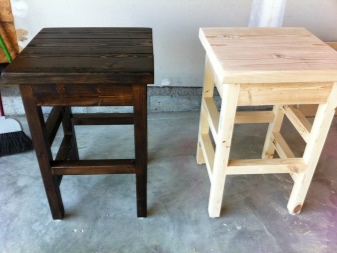
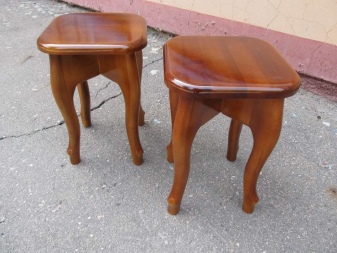
To make a wooden stool as durable and comfortable as possible, it should be dried at a temperature of +20 to +30 degrees. In no case should kiln-dried wood be taken, so that there is no chance of cracking. After this type of drying, the material should be dried at home within 30 days. It would be better to select hardwood for such products - birch, maple, wenge. If there is no such material or there is not much of it, then legs should be made from it. And here the seat can then be made from spruce, pine, or plywood, chipboard or MDF... Given the prevalence of these materials, little should be said about them.
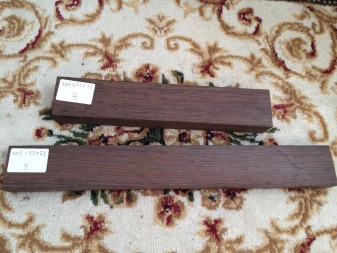
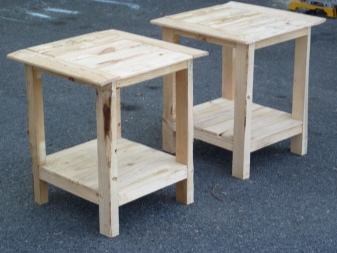
MDF is a fairly durable and environmentally friendly material. But it will be possible to use it in the creation of any furniture only in combination with hardwood. Supports or legs are never made of MDF. But the seat can be made either a cover. If we talk about chipboard, then this material is considered the cheapest. But its reliability will also be appropriate.
At the same time, it has a number of advantages, among which are resistance to moisture. But given that we are talking about creating a stool, strength will be the main criterion. And this material cannot boast of it. It is practically not used at all for the manufacture of furniture. Yet one serious disadvantage of chipboard is the constant release of formaldehyde resin, which makes the use of this material even hazardous to a certain extent.
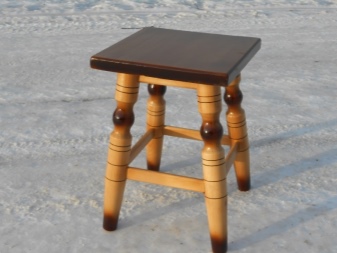

Plywood is not a bad option. True, here the very design of the stool should be adjusted to the material due to the not too high strength. Usually good plywood stools can only be made from 3 or 4 pieces. They are called box-shaped. They are very common now. Note that today there are stools made of other materials: from a profile pipe, plastic or polypropylene pipes. But most often the material is, of course, wood.

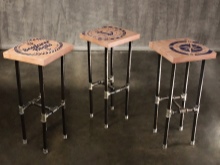
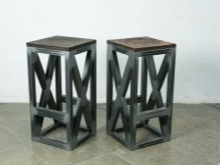
If we talk about tools, then everything will depend on the materials used. For a wooden stool, you should have on hand:
- emery;
- screwdriver;
- tape measure;
- square;
- epoxy glue;
- self-tapping screws;
- electric jigsaw;
- chisel.
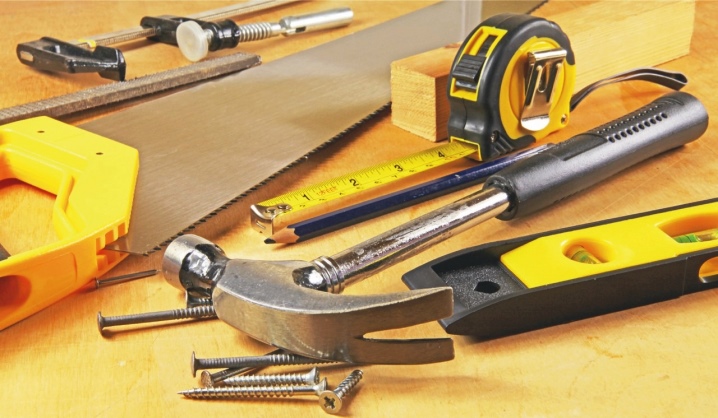
Another important component, without which you cannot start creating a stool - a drawing or a detailed plan for creating a stool... Such instruction point by point will be especially in demand among people who have no experience in creating such products. The diagrams must contain all the necessary characteristics not only of the product itself, but also of its constituent elements.
It should be said that schemes with dimensions can be made independently. True, for this you need to have certain knowledge in geometry.
Another option is to use special computer programs., which will allow you to quickly make the necessary calculations and get drawings. The third option is to download them on one of the specialized Internet resources. Which option to choose is up to everyone to decide.
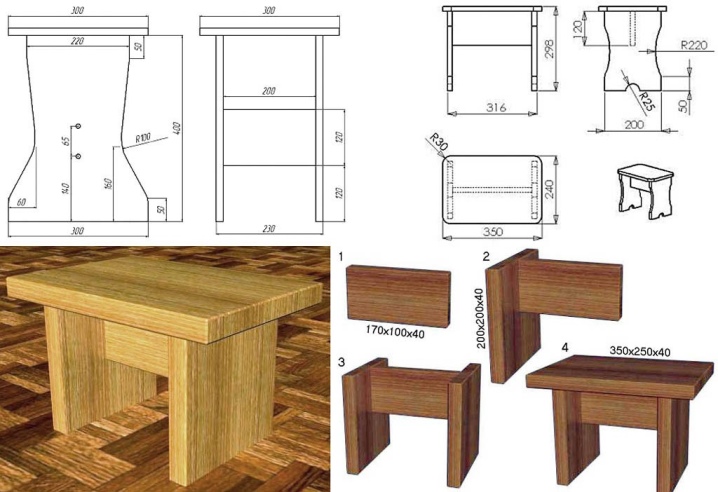
How to make a classic stool?
So, let's start considering the process of creating the product in question with the possibility of creating a classic stool. To create it, you will need to have the following components.
- 4 legs for perfectly smooth legs. They can be straight or narrowed downwards from the inside.
- 2 or 4 boards, or a plywood panel from which the seat will be made.
- 4 prinots, tsars, or both options at once.
- Various kinds of connecting parts in the form of middle pieces of timber, if necessary.
- A bar for creating the so-called "crackers", if they are provided in the design of the chair.
- 4 wooden chopiks that will be used to secure the seats to the finished base.
- Special adhesive composition.
- Self-tapping screws.
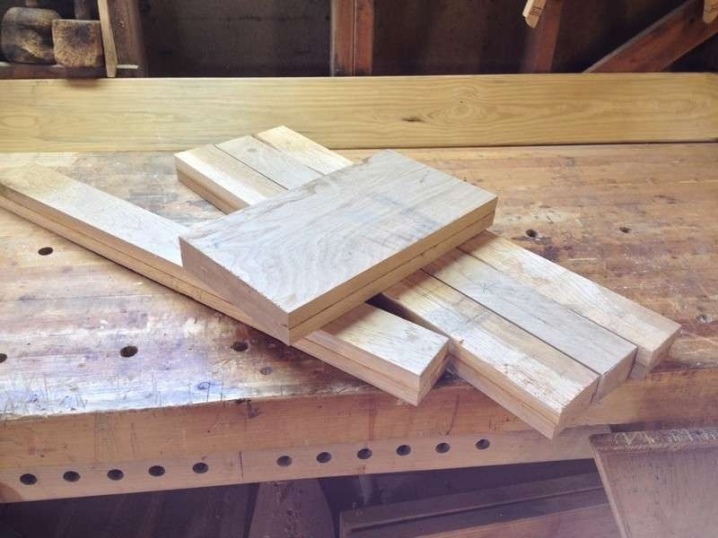
So, in the beginning it will not be superfluous to glue the boards for the seat if the design assumes that it will be formed from several parts. To do this, you will need to glue the perfectly fitted and sanded end parts of the boards with glue, then connect them and tighten them in clamps. Now this part of the structure should be allowed to dry well, but for now, you should deal with the frame of the stool.

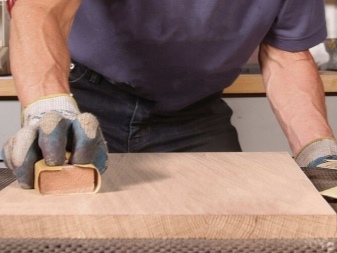
You can start preparing the blocks from which the legs will be made. Their cuts should, if possible, be as flat as possible and have one level of height in a certain range at the request of a person. We mark the legs, after which we determine the location of the selection of the connection grooves for mounting the thorns of the prinots and tsars or one thing there. The holes can be selected using a chisel or a router. Now it is necessary to carry out the processing of the edges of the tsars and princesses. It is required to cut spikes of a certain size, which should be slightly smaller than the grooves in the legs. This is done so that the pins fit relatively freely into the grooves, but as tightly as possible.
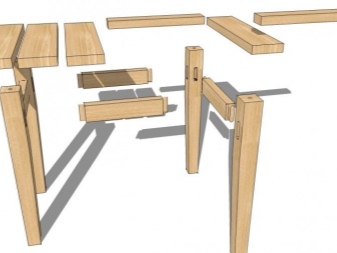
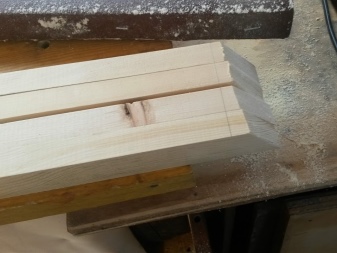
The legs are collected in pairs, we fasten them with tsars and prinots. This is done by gluing the spike elements into the grooves of the legs. The resulting frames should be tightened in clamps. When they dry, it is also necessary to connect the legs, connected in this way, with tsars and prinots into one structure of the base of the product, and then squeeze them again in the clamps until the final gluing. When the glue dries, the joints should be fixed with self-tapping screws for greater confidence.
If the structure of the product will be strengthened with "crackers", then they should be screwed to the leg and hags. This element will be an additional support for the seat.
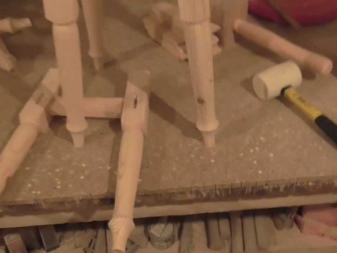
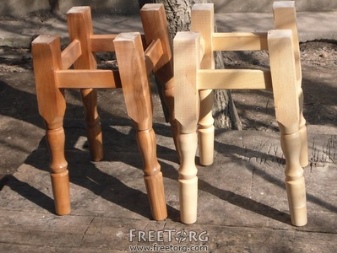
Now you should fix the stool seat directly, having previously marked everything. To do this, first apply glue according to the markings on the other side of the seat, then lay it on the base of the product, align and press firmly.
After that in the corners, through the seat panel, drill through the hole... Their size should be somewhat larger than that of the finished dowels by about a couple of millimeters. And the depth should be somewhere 5 millimeters less than the height indicator. Glue should be poured into the hole made, and then the dowels should be hammered. The glue that comes out must be wiped off immediately. The top of the dowel must be cut off using a router, after which this place must be sanded to smoothness.
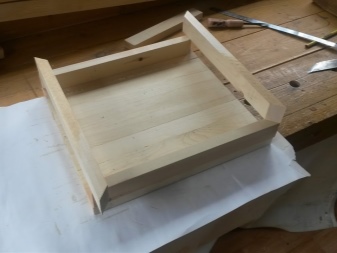
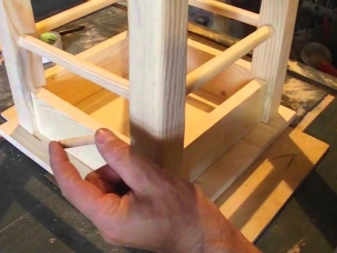
Now the seat should be tightened with the side bar using clamps until the glue is completely dry. It should be added here that different adhesives will have different drying times, which is why you should carefully read the information on the packaging that is indicated by the manufacturer. It is possible to use the product for its intended purpose only after the adhesive composition has dried completely.
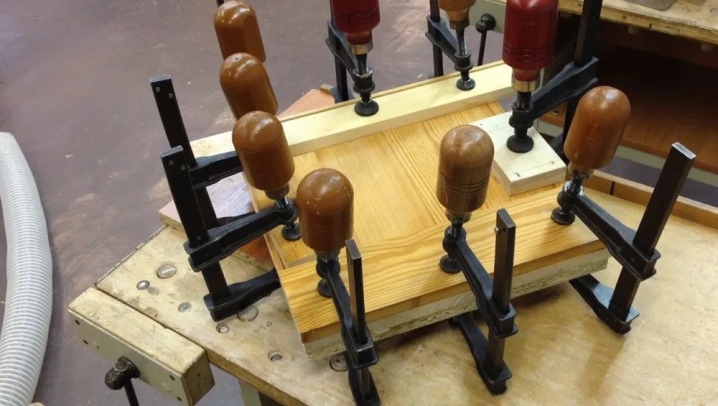
Other interesting options
It should be said that there are a large number of different types of stools that differ in design and complexity. Consider a few more rather popular and interesting options.
Folding
Another common version of the product in question is a folding stool. Such a transformer is convenient in that due to the fact that it folds, it is easy to transport and move. For example, he can be brought to the dacha or brought to the bathhouse, and then carried away. To create it, you will need the following materials:
- self-tapping screws;
- special glue;
- dowels or chopiki;
- stain or varnish;
- 4 furniture butterfly loops;
- a hairpin with a thread cut in 2 sides and end-type nuts, as well as a hairpin with blunt ends.
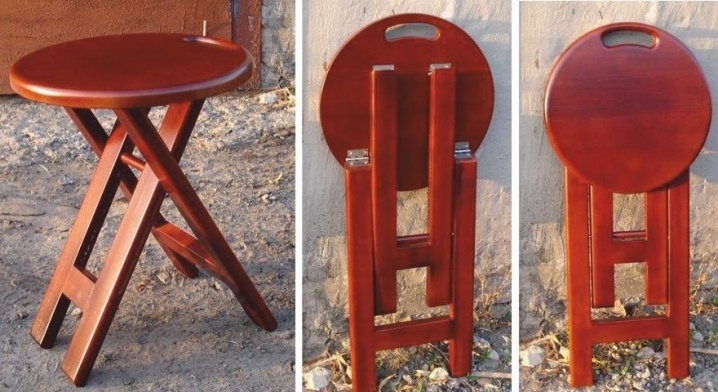
So, first we need to take the seat and make a hole in the upper part of it so that it is convenient to grasp it with our hand. You can do it using a router, after which its edges will need to be immediately processed with an emery or a rasp, bringing the tree to maximum smoothness. Now you can start processing the pre-prepared bars to create the legs. In those two that will create an external type frame, a groove should be cut out where the hairpin will move. Sometimes they are made through. Then a threaded stud at the ends will be used, where a special nut will be screwed.
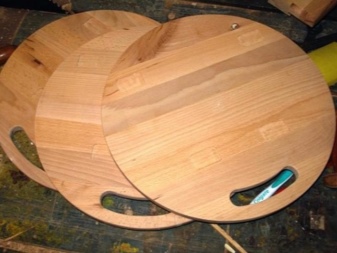
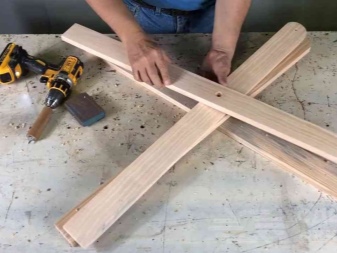
In another pair of bars, through holes should be made, where the hairpin will move. They will create a narrow frame. The next step is to cut out the grooves using a router. Or, along the previously marked line, holes should be drilled, which should then be combined into a common groove. You can use a jigsaw here. It is better to do this on a special machine. If it is absent, then the bar should be fixed as tightly as possible in a vice, and then make holes with a drill or screwdriver.
The bars that will make up the inner frame must be carefully sawed off from above at a 30-degree angle. Moreover, it must be done as accurately as possible, you cannot do without a special machine.
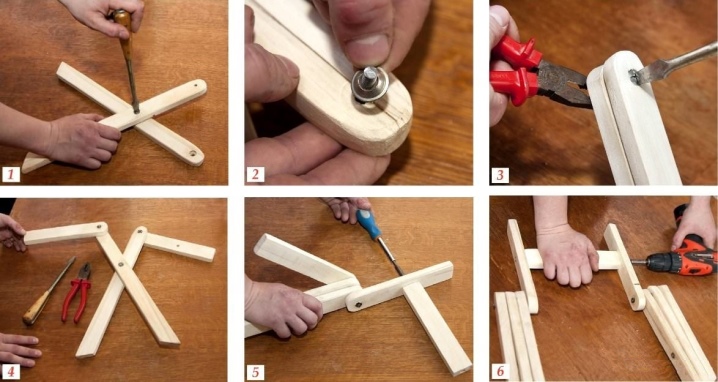
At the next stage, the crossbars are installed on dowels, which are glued to the holes made. Now on the other side of the seat we mark the places where the butterfly loops will be installed. Then we lay them on the marked areas and outline, after which we select a landing nest, which in size will equal the thickness of this element.
The next step is to fix the loops on the upper end parts of the legs. This can be done using self-tapping screws. By the way, their hats should be in the same plane as the surface of the loops. Later the other side of the hinges is attached to the prepared slots on the other side of the seat... Now we close the hairpin with a special tube that was previously made of wood. If there is no desire to waste time on this, then you can use a plastic tube. We insert the pin into the frame narrower through a special tube, and its ends are mounted in the grooves of the larger frame, where they will move when the product is folded and unfolded.
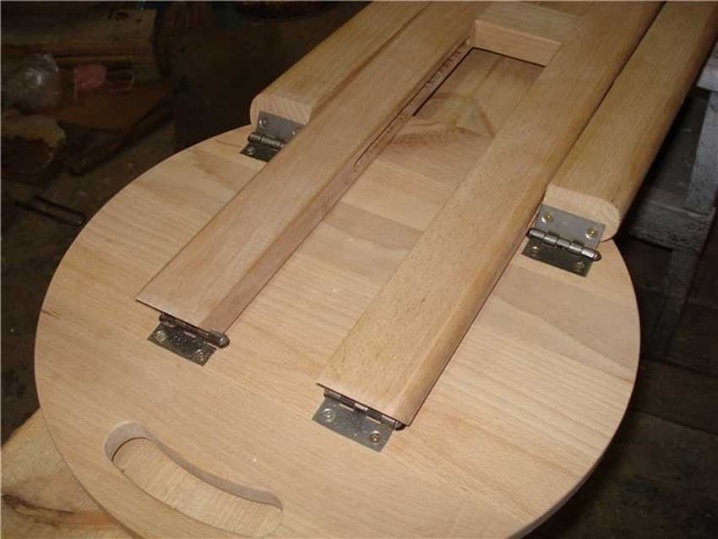
It should be said that there is a slightly simpler version of this design. It uses 2 studs instead of one, and the inner frame is replaced by a solid board, which will be the leg for the stool. The outer frame will have a special jumper at the bottom at a certain level. On it, the board-leg will carefully enter the panel, forming an integral structure. This option will be a little easier to execute.

Child
Another version of the stool that I want to consider is for children.Such a small chair can be useful not only for children, but also for an adult. The advantage of such a stool will be its small size and low weight, so that even a child can move it to the right place. To create such a chair, it is better to take a linden tree. It has a wonderful natural structure. And its density is low, which allows you to significantly reduce the weight without losing strength. The chair will consist of the following parts:
- seats;
- a pair of racks.
It is better if the board has a thickness of 3-4 centimeters. The legs can be carved to give the chair a beautiful look.
Here it must be remembered that such products for children should not have sharp corners, which is why all parts should be immediately rounded.
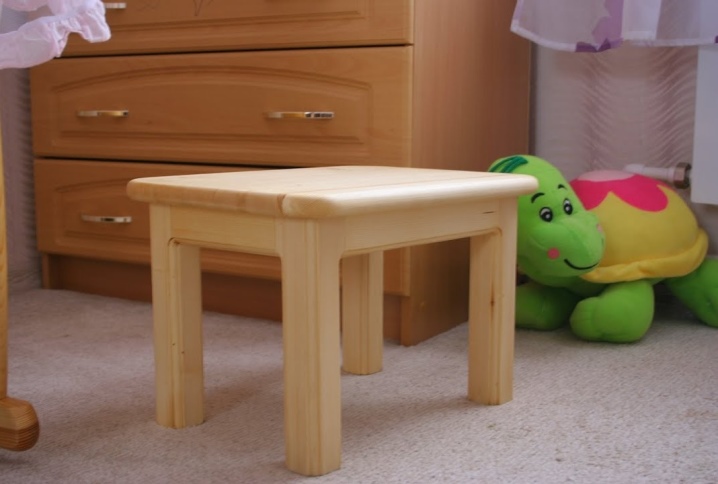
It is better to fasten the parts together with dowels. Any other fasteners are not required here.
When the chair is assembled, it should be very, very carefully sanded so that the children do not get hurt and do not drive a splinter into their fingers. By the way, if you don't want to invent anything, then you can make such a chair from an old stool, if there is one in the house. It's just that then the materials for creating the chair will need to be processed and given a more presentable look.
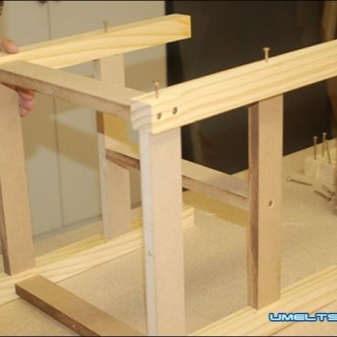
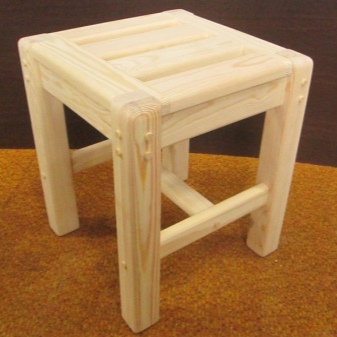
With wicker seat
Beautiful homemade chairs come with a wicker seat. To create this type of stool you will need:
- bars;
- self-tapping screws;
- metal or wooden "crackers" - corner elements;
- bars for prinozhki and tsars;
- synthetic or leather belts.
First, you should make the design of the stool. Usually they start with the legs, the ends of which should be as flat as possible so that the chair is stable. Because of this, they need to be marked in a square, and cut using a circular saw. After that, we prepare the bars for the tsars and princesses.
A total of 8 bars are needed. 4 will be one length and 4 will be different. They should also be with straight edges so that they fit as tightly as possible to the legs.
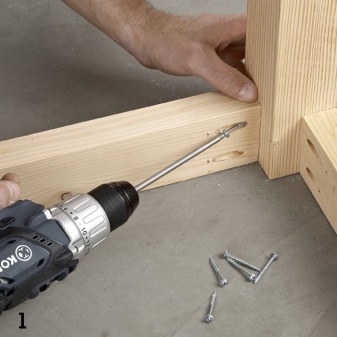
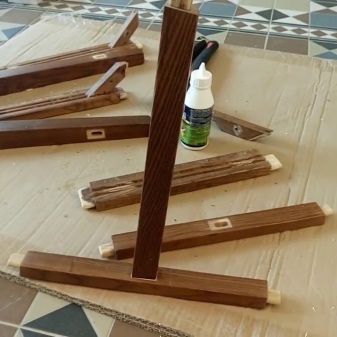
Now you need to make holes for attaching parts of the structure at the required angle. Here you will need a special jig to guide the drill bit wherever you need it. When the parts of the product are done, they need to be very carefully cleaned. With the help of self-tapping screws, we assemble and fix all the elements of the stool together and check the base for strength. We paint it if necessary. This must be done before installing the seat.
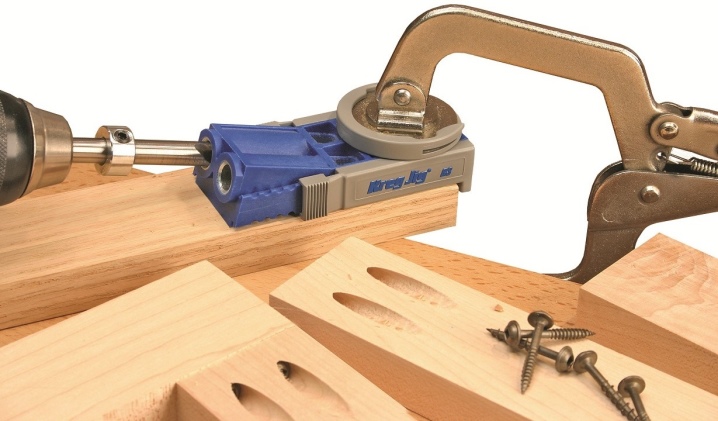
To make a seat, you need leather or synthetic belts. First, they need to be screwed with a pair of self-tapping screws at a certain distance to a wide part of the bar, which goes inside the chair frame. It is required to measure the length of the belts in advance. When they are secured from the inside, they need to be pulled through the seat frame to the opposite side frame and secured there in the same way.
Now we stretch out other belts that will intertwine the stretched belts across and fix them to create weaving. And they should be wrapped on the inside of the opposite side, pulled and screwed. There are other ways to create weaving, but this one can be called the simplest.
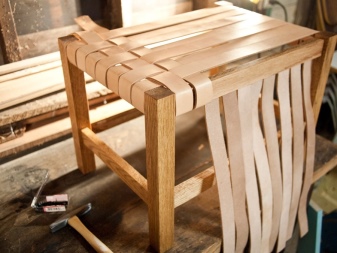
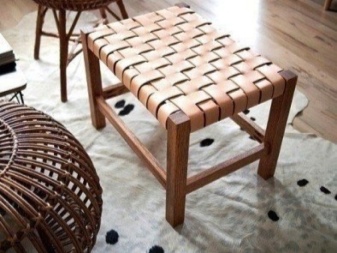
Registration
If we talk about the design of a stool, then everything will depend on the room where it will be located, as well as interior items. An example is the option of applying a pattern to the surface of the seat with spray paint using a stencil. Then the surface should be varnished.
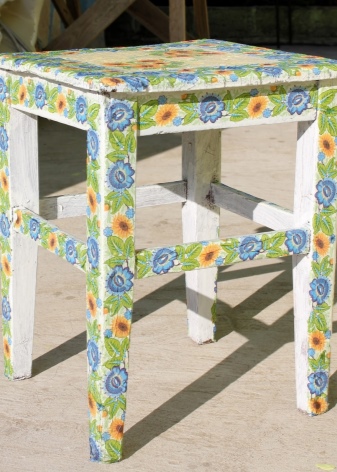
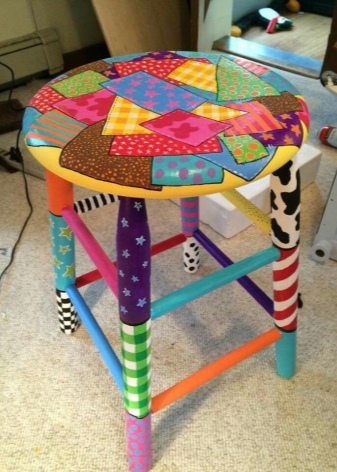
As another option, you can use a rather non-standard move and design a retro chair using decoupage. The complexity in this case will be high, so you can connect one of the family members to the process. For this you will need to have acrylic varnish, PVA stationery glue, as well as beautiful napkins on hand.
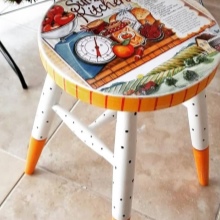
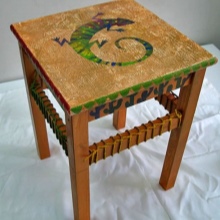
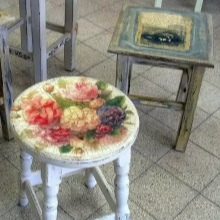
What if don't want to waste too much time, you can only decorate the seat of the stool... This can be done simply by laying a thin layer of foam rubber, after which decorate it with some beautiful and pleasant fabric and decorate it with some fittings at your discretion. In general, as you can see, there are many ways to design a homemade stool. You can even just lay a pillow or make a cover.
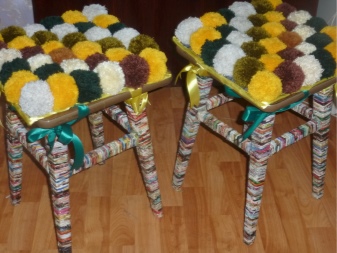
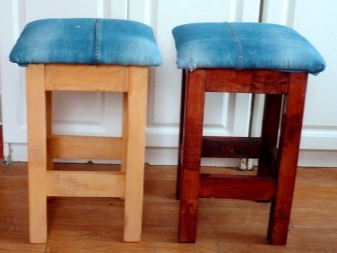
Recommendations
The first point I want to say is that you should not neglect the creation of drawings. Vice versa, drawing documentation should be as detailed and accurate as possible, because any discrepancy will lead in practice to the fact that the stool cannot be used normally for its intended purpose.
Another important recommendation is to use only the correct types of wood if you are making your own wooden stool.
The fact is that the strength of different types and types of wood is different. And it often happens that what fits the legs is completely unsuitable for the seat. Therefore, you should be very responsible in the selection of material for creating a stool.
The third important aspect is that you should choose a quality varnish and wood stain for wood processing. In addition, you should not neglect the initial processing of wood from irregularities. This will give it an aesthetic appearance.
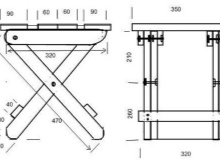
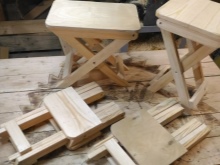

How to make a stool with your own hands, see the video.













The comment was sent successfully.